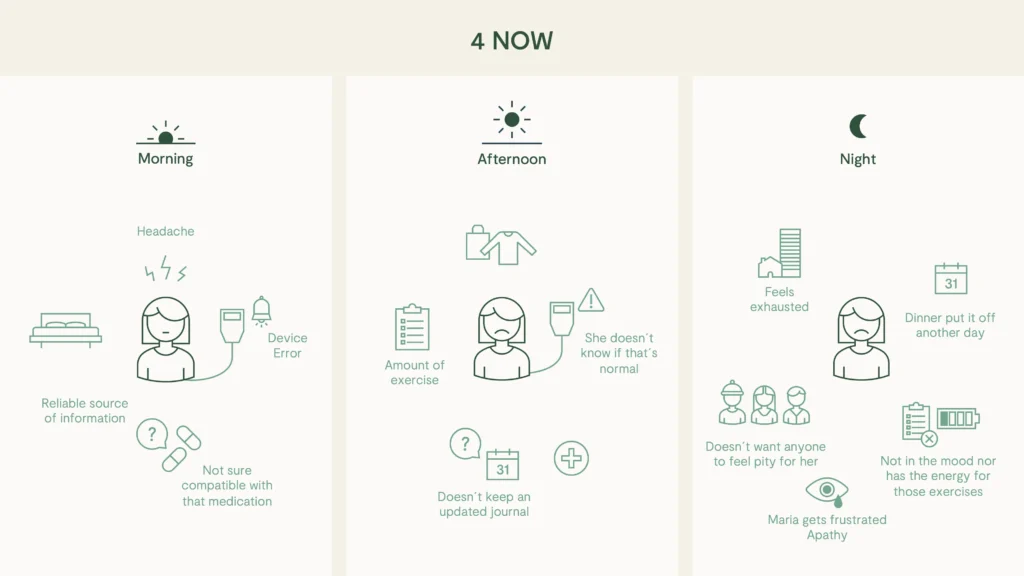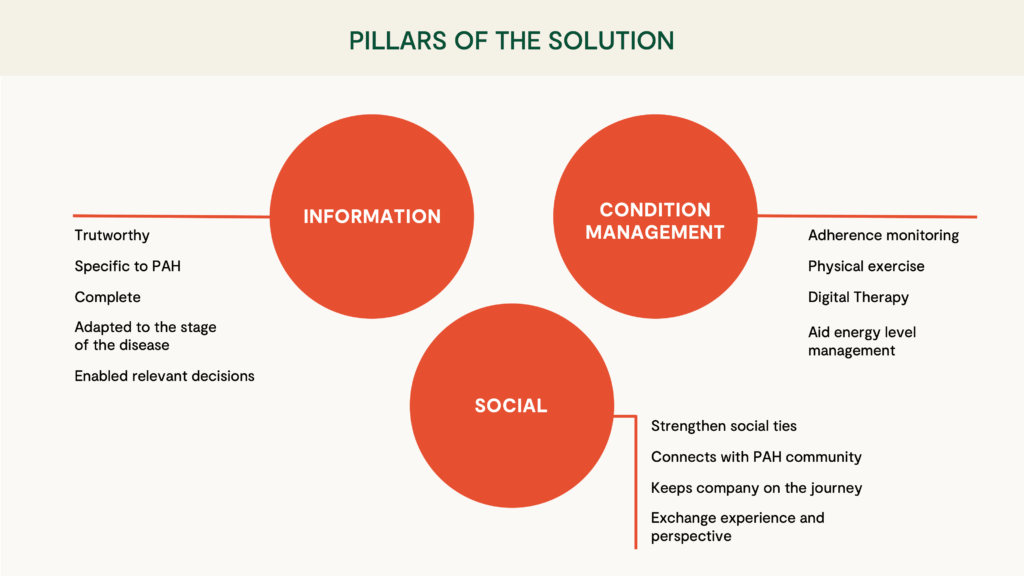Many Digital Health product companies, attracting record-breaking investment even half-way through 2020, are still focussed on generic, ‘one size fits all’ platforms. Take Wellthy Therapeutics, for example, who beat us at pitching a Digital Health solution for Pulmonary Arterial Hypertension (PAH) patients to pharmaceutical executives at Ferrer.
Wellthy have built a “smartphone-based lifestyle management programme for people with chronic conditions”. I, for one, would argue that a platform initially built for diabetes does not necessarily translate well to other, very different chronic conditions such as PAH. In fact, it enitrely misses one of only three key pillars of the patient-centred solution we present below. On the other hand, however, their platform pitch had a key strength against our proposal: an already developed and partly proven programme. So why would one endure the hard work and time of developing something from the ground up, then?
In a rare opportunity to share our work, which usually remains confidential, we showcase the generation of a concept for a Digital Health solution to enhance PAH patients’ quality of life. We invite you to consider the pros and cons of the two models: bespoke vs. generic, holistic vs. partial, patient-centric vs. ‘platform’ push. Tell us what approach you think is best in the comments below!
Let us start with why we worked on this project:
Pulmonary Arterial Hypertension is a rare, chronic disease that rapidly deteriorates quality of life.

Thanks to patient associations such as FCHP, and pharma companies like Ferrer, both the standard of care and life expectancy for PAH patients has greatly improved over the last decade. But patients are still missing out on the solutions that today’s technology could afford them. In this context, Ferrer launched their first challenge to start-ups in the Barcelona Health Hub ecosystem and globally.
“Most importantly, we drew in patients, caregivers, leading cardiologists, and pshychologists […]”
At Perdigó, we saw an opportunity to make a difference in people’s live’s through medical technology, and rapidly assembled an experienced, capable and enthusiastic team alongside UpDevices and Lyra Innovation. But perhaps most importantly, we drew in patients, caregivers, leading cardiologists, and psychologists with years of experience in supporting PAH patients.
One pitfall we knew to avoid was having a biased concept of the solution. Some on the market, for instance, focus only on monitoring adherence, are entirely based around the capabilities of certain sensors, or exclusively deliver telemedicine.
Instead, we started with the patient, her environment and journey:
Patients and psychologists showed us how important social support is, including a tight and helpful community brought together by patient associations. Together, we had a glimpse into the daily life of someone who suffers from PAH; Picture this day for Maria:

- Morning: She weaks up with a headache, and her infusion pump beeps with an error. Once she has swapped the pump for the spare one, Maria wonders if a paracetamol would be compatible with her medication – but doesn’t know where to check.
- Afternoon: While trying on new clothes at a store, Maria notices her skin reddening around the injection site, and doesn’t know if it is normal; She worries and changes plans to visit her cardiologist. Maria is no longer keeping an updated journal and this limits how useful the consultation can be. The doctor prescribes her new exercise routines.
- Evening: Maria feels too tired to go out for dinner with friends, and she is neither in the mood nor has the energy for those exercises. It all leads to frustration and apathy, and she won’t contact others out of fear they may feel pitty for her.
The above picture highlighted the problems to solve, digitally or otherwise. Working once again shoulder to shoulder (this was before COVID!) with patients, caregivers and doctors, and with significant input from our Human Factors lead Alexandra Estruch, we pictured this future:

- Morning (4 future): Connecting to the device, the digital solution gives Maria context for that specific pump error. Tailored and trustworthy drug compatibility information allows her to confidently take an iboprufen – and crucially not a paracetamol!
- Afternoon (4 future): Maria also learns that the reddening of the injection site is normal a few hours after changing pumps; it should ease shortly after. A digital diary is built automatically for her, allowing for more meaningful conversations with her cardiologist – but not today, she’s out shopping.
- Evening (4 future): Having her activity tracked not only helps her manage energy levels throughout the day, but also helps her meet the prescribed exercise guidelines. There is a sense of achievement in that! Maria feels positive and goes out to dinner with friends.
“The right digital health solution for PAH patients features this trinity of pillars: Social, Information and Condition Management”
What comes next is perhaps one of the more difficult steps in generating the right concept solution: finding the connection between the various problem-solution scenarios and distilling them into solid foundations for a digital health product that will change people’s lives for the better.
In the case of Pulmonary Arterial Hypertension, the right Digital Health solution features this trinity of pillars: Social, Information and Condition Management.

We had a well grounded concept, but had we forgotten about the market, the necessary ‘flow of money’ that makes good ideas a reality for people? No, we had just not started there. And when we looked, all the pieces fell in the right place. You name it, we had it: ‘closing the loop’ with data, enabling value-based healthcare, dealing with the patent cliff, reinforcing QALY valuation, and even big data for a rare disease.
“You won’t find App screenshots below”
App screenshots have long been captivating marketing material in this field, but they are rarely relevant when conceptualising a Digital Health solution. The right one might not even take the form of an App, or perhaps the App is just part of the picture! This is why you won’t find App screenshots below.
Sadly, it is also true that we did not convince the sponsor to take this project any further, so we haven’t had the opportunity to develop an actual implementation of the Digital Health solution concept we have presented.
Whether you can help us make it a reality or not, we want to share the holistic, patient-centred approach and learnings from this project. Here are the headlines:
- Involve patients. And caregivers, doctors, pharmacists, phsychologists… Don’t just surround yourself with them, but put them at the centre of the action.
- Focus on the patient holistically: think about their environment, their journeys and their problems with no pre-conception of the solution. We were surprised by learning how important social support is to PAH patients, for instance.
- Distill problem-solutions into solid concept foundations. Critically, avoid the temptation to think about an implementation at this stage.
- Check with broader stakeholders: product managers, pharma executives, payors…
- The next steps, namely digital prototyping, implementation, deployment and maintenance, are not necessarily less important than the concept, but they will only be worth it if you’ve worked hard early on.
See Case Study: Digital Health

